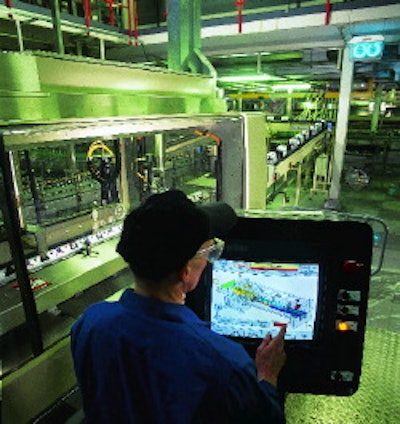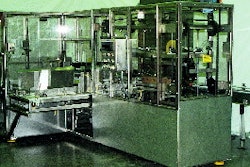Turn-on-a-dime changeover flexibility is not something that's usually associated with production lines owned by high-volume brewers. Bass Brewers, Staffordshire, England, bought into that concept by building a highly flexible, $90 million bottling and canning facility in Cape Hill near Birmingham in central England two and a half years ago. Designed at the outset for frequent changeover, the plant's two bottling lines and one canning line are each changed over at least once a day. "We have been known to run three different bottles in a day," says Eifion Hughes, technical support manager at the Cape Hill brewery. With over 150 SKUs packed on the three lines, Bass accommodates growing demand for both export and domestic packs. In fact, the brewery just added a third shift. Wringing even more flexibility out of Cape Hill is a recent upgrade to a new breed of multipacker that provides fully automated three-dimensional size changeover at the push of a button. Apart from the 10 to 15 minutes required for an operator to manually swap out starwheels and timing screws, the automatic portion of the changeover takes about 15 seconds. That's compared to an hour and a half previously. The machine, a Marksman® 2000 from Riverwood Intl. (Atlanta, GA), is the first of its kind. Installed in February, the machine is only one of two worldwide; none are in the U.S. so far. This particular machine produces wrap style packaging, a format that's popular overseas. Unlike expensive preglued six-pack basket carriers that consumers in the U.S. market have long been accustomed to, a wrap consists of a flat paperboard blank that is folded over the top and sides of a group of bottles, and is mechanically locked underneath. The ends of the pack remain completely open. Bottle crowns, or even the entire neck of a long-neck bottle, can protrude through the top of the wrap. Or, for more billboard area, the wrap can cover the crowns. The wrap also affords more pilfer-resistance than a basket carrier. Bass uses it for its offerings in export markets such as Saudi Arabia as well as England and Scotland. (The wrap is not used for beer exported to the U.S.; rather, Bass uses traditional preglued six-pack carriers. See "Unique basket packer," page 24.) Wraps are offset-printed mostly in five colors plus an emulsion finish on Riverwood's Aqua-Kote® wet-strength carrier board in calipers from 18 to 20 pt, depending on configuration. Though Bass runs the in-line machine at the line's fixed 750 bottles/min speed, Riverwood says the machine is capable of 1꼀 bpm or 300 packs/min, leaving Bass plenty of capacity for future growth. Dumpies drive demand Bass installed the Marksman 2000 to better respond to burgeoning demand in the U.K market for "dumpies," British slang for squat, 250-mL bottles of beer that are offered in 10-packs. Bass sells Grolsch beer in the 250-mL/10-pack size, which it currently imports from a French copacker. (Bass licenses the right to market the Grolsh brand in the U.K.) The plan was to run the popular 10-packs on the Marksman 2000 right at Cape Hill instead of at an overseas copacker. However, demand for Bass's other products has been so strong that Cape Hill's existing bottling capacity is being used to meet that demand. The decision was recently made to continue producing the 10-packs at the copacker for the time being. As a result, the Marksman 2000 is currently used for three different package styles: over-crown six-packs of 330-mL bottles of Barbican non-alcholic beer and lemonade, exported to Saudi Arabia; neck-through four-packs of 330-mL long-neck bottles of Tennent's Gold for the U.K; and over-crown four-packs of 275-mL bottles of Grolsch for the U.K. The two 330-mL bottles differ in shape, size and diameter. Dual infeed The multipacking process starts out as filled, capped and labeled bottles enter the dual lane infeed, passing through starwheels that eliminate back pressure from the line. The starwheels (one per lane) meter bottles to timing screws, also one per lane. The timing screws, also referred to as separator screws, are shaped so that they introduce a gap between groups of bottles as they travel the length of the screw. For example, a timing screw for a six-pack will create gaps between groups of three bottles in each of the two lanes. There's a different timing screw for each bottle diameter and pack count. Once groups are separated, a bottom lug chain takes over from the timing screws, and begins conveying bottles through the wrap section of the machine. Separately, directly above the bottle infeed, blanks are pulled from a magazine by vacuum cups and pinch rollers, and are conveyed forward by carton lug chains. As they move forward, the blanks convey down a gentle decline until they are positioned over the grouped bottles below. There is no specific mechanism that places wraps over each group of bottles. Rather, the carton lug chain is timed precisely with the infeed screws so that the wraps meet the bottles at just the right point. In the case of neck-through wraps, the paperboard simply falls by gravity over the bottle necks. For wraps that are to be positioned over the bottle crowns, the overhead transport system maintains contact with the wraps after they've been deposited. Positive contact with the wrap continues until it is subsequently compressed around the bottles. This also ensures that the wraps are pushed down tightly between bottle necks. The overhead transport system consists of a lug chain that's timed to the bottom lug chain that transports the bottles. (For neck-through wraps, the overhead transport is deactivated since the wraps are positively trapped around the bottle necks.) In the wrap section of the machine, a series of rotating "knock down" hooks plow both sides of the wrap down. Side rails keep the sides of the wrap down until the package enters the bottom sealing section of the machine. To accommodate the bottom folding apparatus, the bottom transport system gives way to a side lug chain, freeing the area underneath the packs for the machine's 21/2'-long locking section. The side lugs--which engage the wrap through die-cut holes at the pack's base--first compress the wrap around the product by bearing down on the wrap as it conveys towards the locking section. The locking section is interesting in that it contains no moving parts; rather, the flaps are mechanically locked together simply by transporting the package across a stationary guide with channels in it. Following the path of the channels, the female flap is folded up underneath the pack first, followed by the male; tabs on the male are inserted into slits on the female. Riverwood's patented S-latch locking system consists of a series of die cuts and scores in the wrap that create what is in effect a double lock. This provides positive locking assurance, without the use of adhesives. As a final step, the edges of the top panel at the two open ends are creased downward to form about a 1" downward-pointing flap. These mini-panels are referred to as ad panels since they can provide extra billboard area for "ads" or additional graphics. They also add some stability to the package. Pushbutton changeover Changeover on the machine, though mostly automatic, does require manual changing of the infeed starwheels and the timing screws, since those parts are dedicated to each bottle shape. For changes involving same-size diameters, the starwheels can stay. And depending on the product, the ad panel tucker may be manually adjusted to alter the pitch. The magazine is then emptied of blanks. Only one operator is required to run and change the machine. The rest of the changeover process is a matter of selecting the desired product from the touch-screen control panel and letting the machine's 11 changeover-dedicated servo drives take over (which are in addition to the 15 servos that are used in the machine's various drive systems). This fully automatic changeover process occurs in several stages. First, the starwheel aligns itself by rotating a few degrees until it's correctly positioned to accept an incoming bottle. Next, the infeed screws similarly align with the starwheels. Finally, the bottom lug chain aligns with the timing screws. Next, both the sleeve magazine and related feeder system move up or down as necessary to accommodate the new bottle height. The magazine itself adjusts in width or height to accommodate wraps of different sizes. The main overhead lug transport system elevates or lowers to accommodate bottle height. The overhead transport system also aligns itself to match the timing of the bottom transport system. Separately, the side guides and side transport lugs move in or out as necessary to adapt to the new bottle widths. Finally, the ad panel tucker aligns itself and sets its own height. All of this takes place in about 15 seconds, and requires only one operator to press a selection on the touch-screen control panel. Pretty unique for a multipacker? "It's very unusual," agrees Hughes. "It's the first I've seen like it." When the automatic portion is complete, the new wraps are then loaded. Hughes attests that the most time-consuming aspect of the changeover is simply the unloading and loading of the wraps. On the previous multipacker, changes were done by handwheels and manually moving guide rails. "It was a no-tool changeover, but it took a long time because it was very manual," says Hughes. He estimates changeover took 30 to 40 minutes, which was done by one operator, plus up to an hour of "bedding in" time, which is time spent correcting any final settings once the line is running at speed. That step isn't required on the new machine due to its higher repeatability and accuracy of changeover, according to Hughes. Though the machine is run sporadically a few days at a time every few weeks, fast changeover is important since at least one or two changes are made during those days it does run. Fast changeover is also critical, says Hughes, since this machine is changed in the context of an entire line changeover. "It's important that each machine on the line can be changed over fairly quickly so the whole process doesn't take an enormous amount of time," says Hughes. "Fast changeover is key in the whole of our packaging operation," he affirms.























